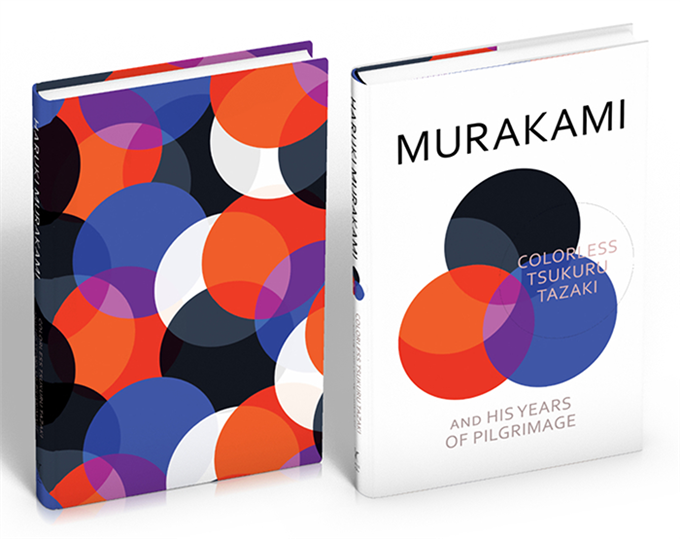
On 12 August, Haruki Murakami’s new novel: Colorless Tsukuru Tazaki and His Years of Pilgrimage comes out in the UK. What will it be like? Impatient to get my hands on a copy, I’ve made predictions about the book in the same way that sports commentators make predictions about games – I’ve done a statistical analysis of Murakami’s novels to date based on several factors: the number of pages, title length, who translated it, and Murakami’s track record over time. From this data, I’ve extrapolated a few guesses about where Colorless… will rate in relation to his other work.
As a reference point to measure the success of Murakami’s novels*, I’ve used the average of each novel’s Amazon UK and Goodreads ratings.
*As we are assessing the potential quality of a new Murakami novel, I have excluded Murakami’s short story collections and non-fiction from the following analysis.
Murakami ratings by number of pages
| Murakami novels in size order | Number of pages | Avg rating |
| South of the Border, West of the Sun | 192 | 4.03 |
| After Dark | 201 | 3.57 |
| Sputnik Sweetheart | 240 | 4.005 |
| A Wild Sheep Chase | 304 | 4.17 |
| Norwegian Wood | 389 | 4.06 |
| Dance Dance Dance | 400 | 4.205 |
| Hard-Boiled Wonderland and the End of the World | 416 | 4.225 |
| Kafka on the Shore | 505 | 4.205 |
| The Wind-Up Bird Chronicle | 624 | 4.09 |
| 1Q84 | 1328 | 4.06 |
From the scatter graph below, we can see that Haruki Murakami’s four top-rated novels (Hard-Boiled Wonderland and the End of the World, Dance Dance Dance, Kafka on the Shore and A Wild Sheep Chase) sit within the 300-500 page range. Murakami’s peak page number is 400, with top-rated Hard-Boiled… at 416 pages and Dance Dance Dance at 400 pages. This suggests that Colourless…, at 304 pages, will be one of his best, but not the best.
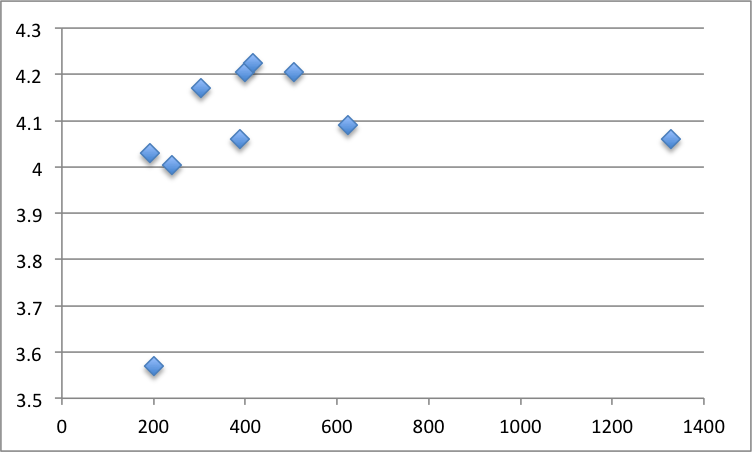
Murakami novel average ratings by number of pages
Murakami ratings by title length
| Murakami novels in order of title length | Title length (inc spaces) |
Avg rating |
| 1Q84 | 4 | 4.06 |
| After Dark | 10 | 3.57 |
| Norwegian Wood | 14 | 4.06 |
| Dance Dance Dance | 17 | 4.205 |
| Kafka on the Shore | 18 | 4.205 |
| A Wild Sheep Chase | 18 | 4.17 |
| Sputnik Sweetheart | 18 | 4.005 |
| The Wind-Up Bird Chronicle | 26 | 4.09 |
| South of the Border, West of the Sun | 36 | 4.03 |
| Hard-Boiled Wonderland and the End of the World | 47 | 4.225 |
The relatively poorly received After Dark somewhat skews the usefulness of this data, but it’s clear that for Murakami, the ideal title length is specifically 17-18 characters long, or more than 45. This bodes well for Colourless Tsukuru and His Years of Pilgrimage, at 46 characters long.
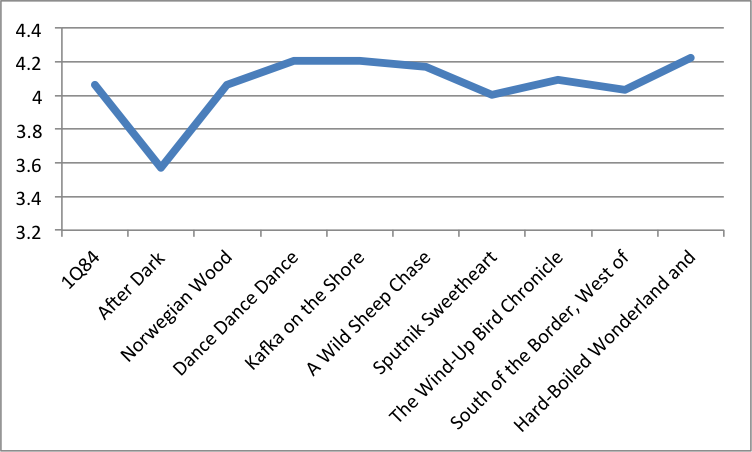
Murakami novel average ratings by title length
Murakami ratings by translator
Haruki Murakami has three translators: Alfred Birnbaum who translated Murakami’s first three novels, and then Jay Rubin and Philip Gabriel, who have swapped back and forth for the remainder, notably translating half of 1Q84 each (Rubin books 1 & 2, Gabriel book 3). Here is the average rating of Murakami’s novels by translator:
Alfred Birnbaum average rating: 4.2
Philip Gabriel: average rating: 4.04
Jay Rubin average rating: 3.9
You’ll note that the margin of difference between Murakami’s three translators is small at just 0.3. Colorless… is translated by Philip Gabriel.
Murakami ratings over time
The chart below shows Murakami’s novels in the order the author wrote them* and their average rating from Goodreads and Amazon UK. It appears there’s a slight downward trend in ratings over time, with the relatively large dip of After Dark. Will Colurless.. reverse the trend and wow the majority who seem to rate his earlier works as their favourites?
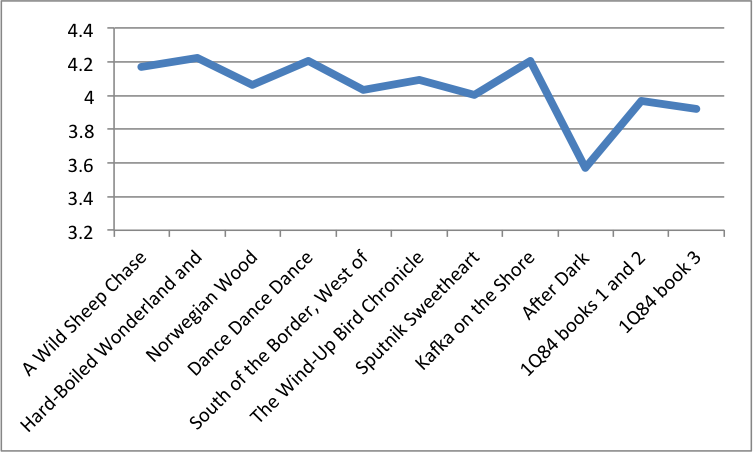
Average rating of Haruki Murakami novels over time
* NB The English publication order of Murakami’s books does not always match the original Japanese publication order. For instance, Norwegian Wood was Murakami’s third novel, but was the fifth novel to be published in English. The Wind-Up Bird Chronicle, Murakami’s sixth novel, was the fourth to be published in English. Below are the Japanese and English publication dates for your reference.
| Haruki Murakami novels | Japanese pub | English pub |
| A Wild Sheep Chase | 1982 | 1989 |
| Hard-Boiled Wonderland and the End of the World | 1985 | 1991 |
| Norwegian Wood | 1987 | 2000 |
| Dance Dance Dance | 1988 | 1994 |
| South of the Border, West of the Sun | 1992 | 2000 |
| The Wind-Up Bird Chronicle | 1994 | 1997 |
| Sputnik Sweetheart | 1999 | 2001 |
| Kafka on the Shore | 2002 | 2005 |
| After Dark | 2004 | 2007 |
| 1Q84 books 1 and 2 | 2009 | 2011 |
| 1Q84 book 3 | 2010 | 2011 |
Conclusion
The data suggests that this won’t be Murakami’s best book ever. But it’s interesting to note that the spread of Murakami’s novel ratings is small, with his top-rated novel (Hard-Boiled Wonderland at the End of the World) having an average rating of 4.225, and his lowest rated (After Dark) having an average rating of 3.57.
After Dark was an uncharacteristically low point in Murakami’s ratings, as you can see from the second graph. If we pretend Murakami never wrote After Dark, then there is a statistical variation in average rating of only 0.22 out of 5.
From this, we can see that Haruki Murakami is a consistently good performer, and we can assume that even if it’s one of the worst books he has ever written, it’s still going to be pretty awesome.
My two pennies’ worth
I don’t trust the statistics because I don’t agree with the Amazon UK ratings. While I do agree that Hard-Boiled Wonderland and the End of the World is one of his best, my own favourite is The Wind-Up Bird Chronicle. I don’t trust the opinion of anyone who’d put A Wild Sheep Chase above Wind-Up…. And 1Q84 was terrific, too, deserving a much higher place in the rankings. I do agree though that After Dark is the least strong book he’s put out to date.
It’s worth noting that Goodreads users voted The Wind-Up Bird Chronicle as Murakami’s best, while Amazon users rated it third from the bottom (although it still got 4/5). It just shows how useless this kind of statistical analysis is when it comes to reading.
This weekend, with the World Cup going on, and Wimbledon, and the Tour de France, it’s been nothing but statistical predictions and jibber-jabber on the telly. It’s this that inspired me to look at the new Murakami book in this way, and it’s this that has reinforced for me why books are better than ball-games, and readers are better than sportsfans.
More reasons to be excited about Colorless Tsukuru Tazaki and His Years of Pilgrimage
- Copies of the first edition will come with stickers designed by five Japanese artists, so that you can decorate your own copy.
- Haruki Murakami is making a very rare visit to the UK to promote it, although VERY briefly. He’s doing an event at the Edinburgh Festival, which is already sold out, and he will be signing just 200 copies at Waterstones Piccadilly on 30 August 2014. Here’s the promotional poster on the wall of Waterstones right now – have you ever seen so many terms and conditions regarding a signing? You know you’ve reached superstar status when your arrival is preceded by a long list of T&Cs.
Here’s the jacket blurb from the Random House website:
Tsukuru Tazaki had four best friends at school. By chance all of their names contained a colour. The two boys were called Akamatsu, meaning ‘red pine’, and Oumi, ‘blue sea’, while the girls’ names were Shirane, ‘white root’, and Kurono, ‘black field’. Tazaki was the only last name with no colour in it.
One day Tsukuru Tazaki’s friends announced that they didn’t want to see him, or talk to him, ever again.
Since that day Tsukuru has been floating through life, unable to form intimate connections with anyone. But then he meets Sara, who tells him that the time has come to find out what happened all those years ago.
And a trailer for the book…

And finally…
There are some interesting quotes from translator Philip Gabriel about working with Murakami in this article in The Australian.
Roll on 12 August…I just can’t wait!
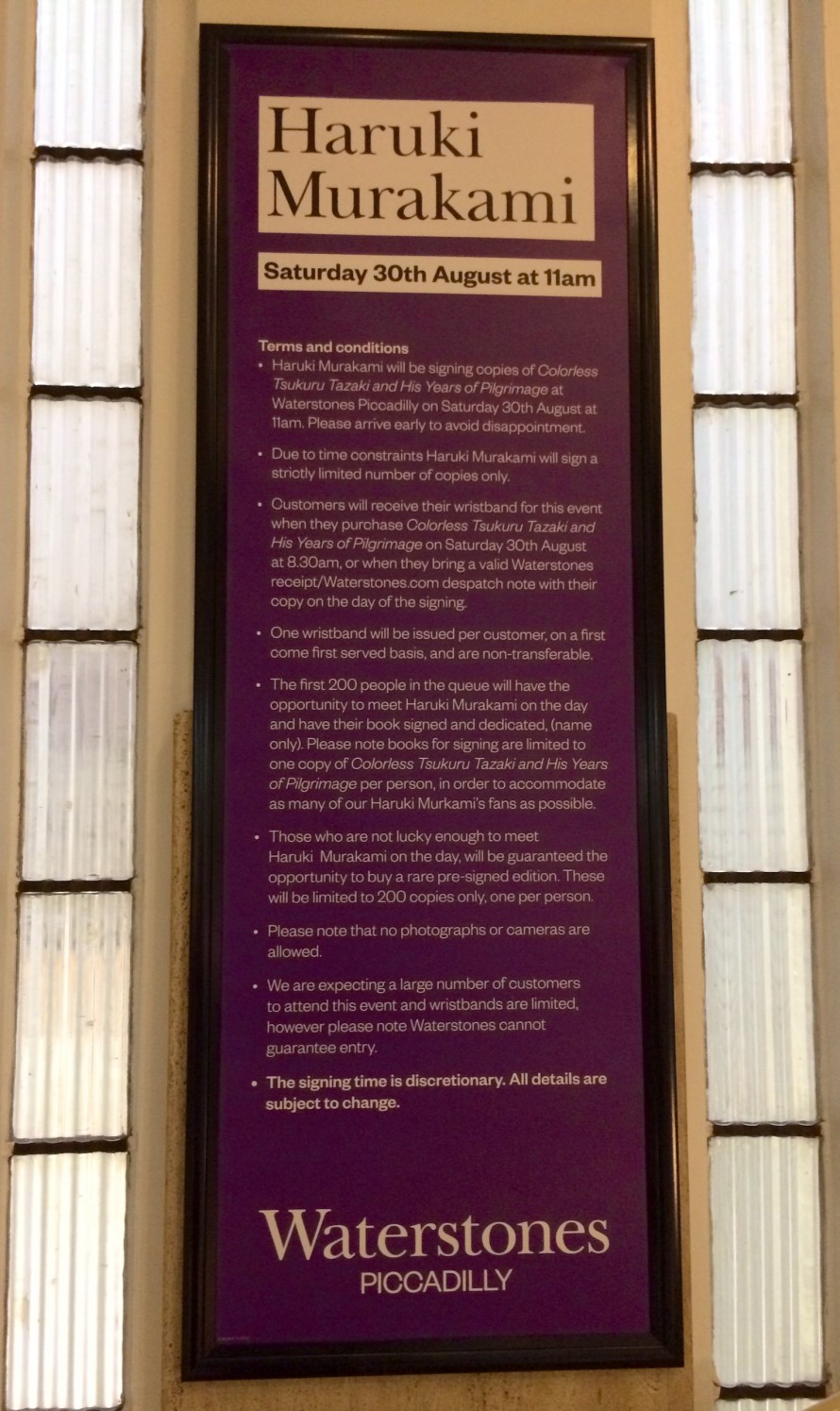
Graphic assessment of literary works! First time ever. However, it does make sense to me given what Murakami writes and the way his products are marketed.